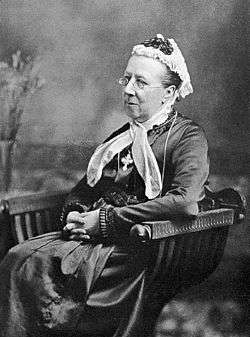Louisa Twining

Louisa Twining (16 November 1820 – 25 September 1912) was an English philanthropic worker who devoted herself to issues and tasks related to the English Poor Law.
Biography
Louisa was born at 20 Norfolk Street (now gone) in central London, not far from her family's famous Twinings tea business on the Strand. She was the ninth and youngest child of Richard Twining (1772–1857), and his wife Elizabeth Mary, née Smythies (1779–1866). Louisa's maternal ancestry is well documented in The Longcrofts: 500 Years of a British Family by James Phillips-Evans (Amazon UK, 2012). In the early part of her adult life, Louisa was an artist and art historian and she wrote and published Symbols and Emblems of Mediaeval Christian Art (1852) and Types and Figures of the Bible (1854). Louisa was the youngest sister of the botanical artist Elizabeth Twining.
In 1853, she became interested in movements for social reform, and began the work in connection with the Poor Law to which she devoted the rest of her life. In March 1861, she helped to establish a home for workhouse girls sent out to service, and in 1864, the Workhouse Visiting Society.
She was a Poor Law guardian for Kensington during 1884-90, and for Tonbridge Union during 1893-6. She promoted the opening of Lincoln's Inn Fields to the public, helped to start the Metropolitan and National Association for nursing the poor in their homes, did much to secure the appointment of police matrons, and was president of the Women's Local Government Society.
She is buried at Kensal Green Cemetery.[1]
Works
- Recollections of Life and Work Being the Autobiography of Louisa Twining. Publisher: Edward Arnold, London 1893
- Workhouse and Pauperism (1898)
- Twining, Louisa (1858). Workhouses and women's work. London: Longman, Brown, Green, Longmans and Roberts.
In addition, she wrote many papers on Poor Law subjects.
- Books published by Louisa Twining Internet Archive - read online
Archives
Papers of Louisa Twining are held at The Women's Library at London Metropolitan University, Reference number 7LOT.
References
- ↑ Paths of Glory. Friends of Kensal Green Cemetery. 1997. p. 100.
-
 Chisholm, Hugh, ed. (1922). "Twining, Louisa". Encyclopædia Britannica (12th ed.). London & New York.
Chisholm, Hugh, ed. (1922). "Twining, Louisa". Encyclopædia Britannica (12th ed.). London & New York.
External links
- Works by or about Louisa Twining at Internet Archive
-
 Works written by or about Louisa Twining at Wikisource
Works written by or about Louisa Twining at Wikisource